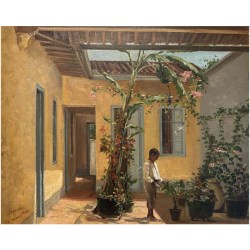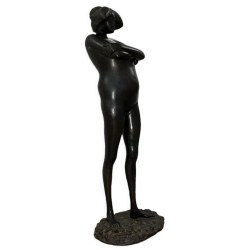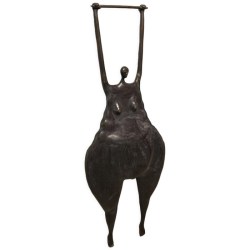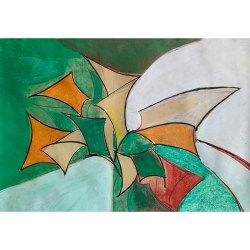Bio
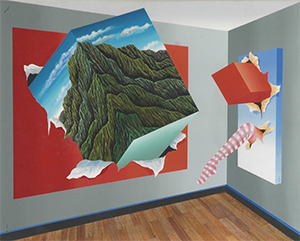
His academic training took place at the School of Fine Arts in Cúcuta, Colombia, and at the School of Plastic Arts in San Cristóbal, Venezuela. Throughout his career, Campos Biscardi has participated in numerous individual and collective exhibitions, both nationally and internationally, and has obtained various awards and recognitions for his work.
Early years and training
Since he was little, José Campos Biscardi showed great interest in the plastic arts. Son of a bullfighter, he arrived in Venezuelan territory in 1953, establishing his residence in San Cristóbal, capital of the Táchira state. There he began his studies at the San Cristóbal School of Plastic Arts, where he developed his skills in painting and drawing.
Later, he continued his training at the School of Fine Arts in Cúcuta, Colombia. During his years of study, Campos Biscardi stood out for his talent and dedication to art, which allowed him to participate in various exhibitions and artistic events from an early age.
Exhibitions and recognition
Throughout his career, José Campos Biscardi has participated in numerous individual and collective exhibitions, both in Venezuela and in other countries. His first solo exhibition took place in 1965, at the San Cristóbal Public Library. From then on, he held several exhibitions in Colombia, such as at the Cúcuta House of Culture in 1964 and at the Bogotá Museum of Contemporary Art in 1968.
In the 1970s, Campos Biscardi moved to Caracas, where he continued to exhibit his work in different galleries and art events. Some of his most outstanding exhibitions in the Venezuelan capital include "Temas del amor y temas de la guerra" at the Instituto de Orientación Artística in 1970, "Las visitas S.A." at the Banap Gallery in 1974 and "Con el Ávila a otra parte" at the Serra Gallery in 1980.
Campos Biscardi has also exhibited in other places in Venezuela, such as at the Ateneo de Valencia, Carabobo State, in 1977, and at the Ateneo de Barcelona, Anzoátegui State, in 1975. Internationally, he has participated in exhibitions in New York, such as in the Venezuela Gallery in 1978, and in the Museum of Costa Rican Art, in San José, Costa Rica in 1984.
Throughout his career, José Campos Biscardi has obtained various awards and recognitions for his work, including:
- Engraving prize for students at the Casa de la Cultura in Cúcuta, Colombia, in 1964.
- Second prize for painting at the San Sebastián Hall, San Cristóbal, in 1965.
- Second prize at the Salón Universitario de Cúcuta, Colombia, in 1966.
- First prize for painting at the San Sebastián Salon, San Cristóbal, in 1967.
- Third prize at the XII Julio T. Arze Salon and Creole Prize at the XII Salon D'Empaire in 1969.
- Andrés Pérez Mujica Award at the XXX Arturo Michelena Salon in 1972.
- First prize at the National Salon of Young Artists of Maracay in 1972.
- Cristóbal Rojas Award at the XXXI Arturo Michelena Salon in 1973.
- Arturo Michelena Award at the XXXII Arturo Michelena Salon in 1974.
Style and theme
José Campos Biscardi's style is characterized by its combination of realistic and dreamlike elements, using peculiar graphic techniques such as the use of stencils for defined contours, spot colors, acrylics, precise masses, halftones, and industrial colors. His works often present fantastic landscapes, in which the human figure and some elements of nature, such as clouds, fields and dense grass, are integrated into a symbolic unity.
Among his most recurring themes is the Ávila hill, an iconic landscape of Caracas. Through his paintings, Campos Biscardi has managed to give new approaches and perspectives to the hill, creating compositions that play with the fragmentation of forms and the juxtaposition of planes.
Another relevant aspect in the work of Campos Biscardi is his concern for the environment and ecology. In his paintings, the artist often addresses themes related to environmental problems, using his landscapes and characters as means to express his critical position against the degradation of the natural environment.
Live work and communication
José Campos Biscardi has also stood out for his interest in communication and the relationship with the public. During the 1970s and 1980s, he held several "arte vivo" sessions, in which he painted his works in front of viewers, establishing a direct and immediate connection with them.
This practice, which sought to break down the conventional barriers between the artist and the public, allowed Campos Biscardi to obtain immediate feedback and learn first-hand about the reactions and opinions of those who observed his work. Despite being criticized at times for his supposed exhibitionism, the artist always defended his approach as a genuine and necessary form of communication in his creative process.
Legacy and contribution to art
The work of José Campos Biscardi is, without a doubt, an important reference in contemporary Venezuelan art. Throughout his extensive career, the painter has managed to establish himself as a recognized artist, both nationally and internationally, and has left a legacy of creativity and commitment to artistic expression.
His contribution to Venezuelan art, in addition to his prolific pictorial production, has also been manifested in his active participation in the promotion and dissemination of culture. In 1979, Campos Biscardi was one of the founding members of the Venezuelan Association of Plastic Artists (AVAP), of which he was first vice president between 1996 and 1999.
Today, his works are part of important art collections in Venezuela and the world, such as the Ateneo de Coro, the Ateneo de San Cristóbal, the Luis Ángel Arango Library in Bogotá, the National Art Gallery of Venezuela, the Museum of Contemporary Art of Bogotá, the Museum of Ciudad Bolívar, the Museum of Graphics in Rome and the Jesús Soto Museum.
In summary, the life and work of José Campos Biscardi constitute a valuable testimony of the richness and diversity of Venezuelan art in the 20th and 21st centuries. His legacy continues to be a source of inspiration and admiration for the new generations of artists in Venezuela and the world.


